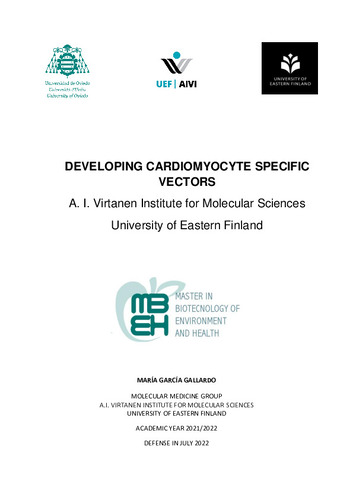Developing cardiomyocyte specific vectors
Other title:
Desarrollo de vectores específicos para cardiomiocitos
Author:
Director:
Publication date:
Serie:
Máster Universitario en Biotecnología del Medio Ambiente y la Salud
Descripción física:
Abstract:
Cardiovascular diseases (CVDs) are the leading cause of global death and new treatments are needed. Gene therapy stands out as a potential treatment option for many disorders, including CVDs, offering new solutions that are less invasive and longer lasting. Gene therapy for CVDs has had recent advances as many treatments are currently undergoing clinical trials. Delivering therapeutic genes to cardiomyocyte cells via viral vectors can improve the wellbeing of these cells, preventing cardiomyocyte from dying in instances of injury. However, specific targeting of cardiomyocytes is still a challenge. The aim of this study was to develop cardiomyocyte-specific lentivirus (LV) vectors using an enhancer element from a cardiomyocyte-specific superenhancer (SE), in order to restrict the expression of the transgene to cardiomyocyte cells. For the project 6 enhancers (CE) belonging to a cardiomyocyte-specific SE were chosen and 4 were successfully cloned into LV vectors and tested in vitro for reporter gene expression. Mouse cardiomyocyte cells and other cell lines were transduced with LV-CE(X), in order to assess their activity and specificity. Flow cytometry analysis of samples revealed high activation but low cardiomyocyte specificity of enhancers CE1, 2 and 3, whereas the activity for CE6 was low in every cell line. Further testing in human cardiomyocytes is necessary in order to determine if this enhancer is cardiomyocyte-specific. Nevertheless, so far no cardiomyocyte-specific enhancers were found in the context of LV vectors and the search is to be continued.
Cardiovascular diseases (CVDs) are the leading cause of global death and new treatments are needed. Gene therapy stands out as a potential treatment option for many disorders, including CVDs, offering new solutions that are less invasive and longer lasting. Gene therapy for CVDs has had recent advances as many treatments are currently undergoing clinical trials. Delivering therapeutic genes to cardiomyocyte cells via viral vectors can improve the wellbeing of these cells, preventing cardiomyocyte from dying in instances of injury. However, specific targeting of cardiomyocytes is still a challenge. The aim of this study was to develop cardiomyocyte-specific lentivirus (LV) vectors using an enhancer element from a cardiomyocyte-specific superenhancer (SE), in order to restrict the expression of the transgene to cardiomyocyte cells. For the project 6 enhancers (CE) belonging to a cardiomyocyte-specific SE were chosen and 4 were successfully cloned into LV vectors and tested in vitro for reporter gene expression. Mouse cardiomyocyte cells and other cell lines were transduced with LV-CE(X), in order to assess their activity and specificity. Flow cytometry analysis of samples revealed high activation but low cardiomyocyte specificity of enhancers CE1, 2 and 3, whereas the activity for CE6 was low in every cell line. Further testing in human cardiomyocytes is necessary in order to determine if this enhancer is cardiomyocyte-specific. Nevertheless, so far no cardiomyocyte-specific enhancers were found in the context of LV vectors and the search is to be continued.
Collections
- Trabajos Fin de Máster [5283]
Files in this item





